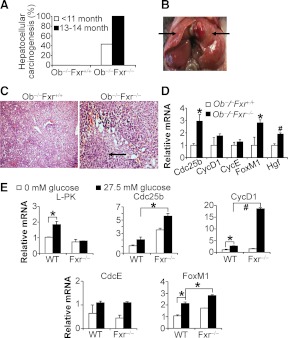Fig. 7.
FXR deficiency accelerates liver carcinogenesis in ob/ob mice. The double-knockout (ob−/−Fxr−/−) mice and their controls (ob−/−Fxr+/+) were fed a chow diet (n = 7–9 mice per group). A, The incidence of liver carcinomas in both genotypes is shown. Forty-three percent of the young ob−/−Fxr−/− mice developed liver carcinomas. B, Representative image of liver carcinoma from an Ob−/−Fxr−/−mouse is shown. C, Hematoxylin and eosin staining of liver sections from ob−/−Fxr+/+ mice (left panel) or ob−/−Fxr−/− mice (right panel) was shown (original magnification, ×100). D, Hepatic mRNA levels were determined by qRT-PCR. Arrows indicate the carcinoma in the liver (B) or microscopic lesion (C). E, Primary hepatocytes were isolated from wild-type or Fxr−/− mice and cultured in DMEM containing 0 mm glucose or 27.5 mm glucose for 24 h. mRNA levels were determined by qRT-PCR. The results represent two independent studies. L-PK, Liver-type pyruvate kinase (positive control). *, P < 0.05; #, P < 0.01.

